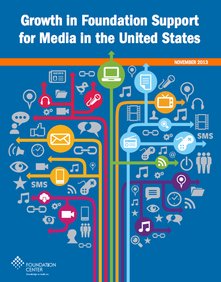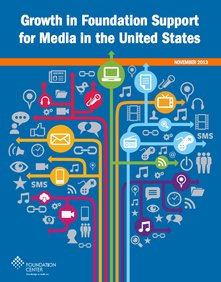
Report on foundation funding for media ignites crucial discussion
As senior adviser to the chairman of the Federal Communications Commission, Steven Waldman was the lead author of “Information Needs of Communities: the Changing Media Landscape in a Broadband Age.” Below, Waldman writes about a report recently released by the Foundation Center—and supported by Knight Foundation—on the growth in foundation funding for media. Photo credit: Flickr user Tony Stewart.
The Foundation Center’s report on foundation funding of media is crucial, well done, fascinating, often encouraging and occasionally disturbing.
I start with the premise that philanthropy needs to put more money into journalism. By giving both advertisers and readers more choices, the digital revolution has been a boon to some aspects of media (storytelling tools, distribution, publications) and devastating to others (support for labor intensive accountability reporting). In the face of that kind of market failure—one that can have profound effects on the health, safety and well-being of a community—philanthropy must step in.
This invaluable report, funded—natch—by Knight Foundation lays out for the first time a clear sense of who’s doing what among the major foundations, and provides a benchmark to measure future trends.
A few takeaways:
RELATED LINKS
“Foundation media support rises—but can it grow even faster?” on Knight Blog by Eric Newton
Growth is good. Media-related grant-making from foundations grew 21 percent from 2009 to 2011. Remember: The idea that philanthropy needed to step up its support for media is relatively new. Ten years ago the idea that a philanthropist should put scarce resources into media—where the Murdochs and Time Warners seemed to be doing just fine—would have been downright offensive. So it’s a good sign that many foundations “get” that the world has changed and that certain types of media need to be subsidized.
Journalism education gets much more than journalism job-creation. During the 2009-2011 period, more than five times as much money went to journalism education as to investigative reporting. In fact, if you subtract the big increase in support for journalism education, the total philanthropic support for the category of “journalism, news and information” actually went down.
As the profession transforms, journalism education is crucially important. Many schools are deploying students in the field as reporters, and are better training them for modern journalism jobs. The problem is that there aren’t enough jobs that put to use their highest-end reportorial skills. To be sure, some philanthropic money that has gone into investigative reporting is from individuals and thus not captured in this report. Nonetheless, foundations need to put as much money into the creation of journalism jobs—opportunities to actually do labor-intensive accountability reporting that helps communities—as they do training the job applicants.
Old media players still dominate. The nonprofit sector, just like the for-profit sector, has its established, “traditional” media players. Amazingly, none of the top 10 recipients of traditional foundations were digital-native startups. Most were journalism schools or public TV or radio organizations. Some of these old dogs are doing new tricks—and the report also shows that a good chunk of the money to traditional players went toward digital projects—but if this is the makeup of the top 10 three years from now, I believe, the philanthropic community will have failed.
Tech tools are more popular than people. As much money went to “interactive games” ($25 million) as to investigative journalism. A total of $108 million went to “media applications and tools.” Many of these are quite important. They equip journalists or citizens with the ability to more efficiently share and extract information. But grants to tech tools also reflect a Pollyannaish view that technology will solve all problems by focusing more on the tech breakthrough than the mundane task of supporting the cost of journalistic labor.
What digital divide? The amount toward telecommunications infrastructure actually decreased from $19 million to $10 million. Shockingly little is devoted to bridging the digital divide. This means that we have the decline in traditional media combined with a shortage in means for lower-income people to access digital media. Not a good combination.
The 19th century robber barons still rock (more than the 21st century digital titans). Scan the list of the top 10 foundations in this field and it reads like a hall of fame from the industrial revolution. Henry Ford started his auto company in 1899. Charles Knight, the father of Knight Foundation founders John S. and James L. Knight, bought his first newspaper in 1903. Andrew Mellon took over his first bank in 1882. The only “digital fortune” on the list of top 10 media funders is the Bill and Melinda Gates Foundation, reflecting the Microsoft co-founder’s being light years ahead of other winners of the tech economy in his commitment to all sorts of philanthropy. Something will be very wrong if five years from now this list doesn’t include Apple, Facebook, Google and Twitter.
Bigger pie. The report raises some interesting questions about foundations’ current priorities within the media space. For instance, given the collapse of journalistic resources does it make sense that only 28 percent of media funding from foundations goes toward “journalism, news and information”? But more important, the pie needs to be bigger, not resliced, which will mean new players. The Federal Communications Commission report estimates that it would take between an additional $265 million and $1.6 billion to fill the current gaps in local reporting. So per year, the $195 million put forth by foundations needs to grow—by a lot. The FCC report also recommended that the nonprofit sector start by getting a better handle on the nature and size of philanthropy. Now we can have a concrete discussion about how much, and how, foundations are approaching this field. That, in itself, is a breakthrough.
Recent Content
-
Journalismarticle ·
-
Journalismarticle ·
-
Journalismarticle ·



